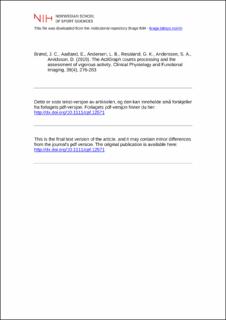| dc.contributor.author | Brønd, Jan Christian | |
| dc.contributor.author | Aadland, Eivind | |
| dc.contributor.author | Andersen, Lars Bo | |
| dc.contributor.author | Resaland, Geir Kåre | |
| dc.contributor.author | Anderssen, Sigmund Alfred | |
| dc.contributor.author | Arvidsson, Daniel | |
| dc.date.accessioned | 2020-04-23T07:47:53Z | |
| dc.date.available | 2020-04-23T07:47:53Z | |
| dc.date.created | 2019-07-30T18:12:43Z | |
| dc.date.issued | 2019 | |
| dc.identifier.citation | Clinical Physiology and Functional Imaging. 2019, 39(4), 276-283. | en_US |
| dc.identifier.issn | 1475-0961 | |
| dc.identifier.uri | https://hdl.handle.net/11250/2652179 | |
| dc.description | I Brage finner du siste tekst-versjon av artikkelen, og den kan inneholde ubetydelige forskjeller fra forlagets pdf-versjon. Forlagets pdf-versjon finner du på onlinelibrary.wiley.com / In Brage you'll find the final text version of the article, and it may contain insignificant differences from the journal's pdf version. The definitive version is available at onlinelibrary.wiley.com. | en_US |
| dc.description.abstract | The purpose of this study was to investigate the effect of different band‐pass filters on the measurement bias with ActiGraph counts during high speed running and for estimating free‐living vigorous physical activity (VPA). Two alternative band‐pass filters were designed, extending the original frequency range from 0·29 to 1·66 Hz (AG) to 0·29–4 Hz (AC4) and 0·29–10 Hz (AC10). Sixty‐two subjects in three age groups participated in a structured locomotion protocol consisting of multiple walking and running speeds. The time spent in free‐living VPA using the three different band‐pass filters were evaluated in 1121 children. Band‐pass filter specific intensity cut‐points from both linear regression and ROC analysis was identified from a calibration experiment using indirect calorimetry. The ActiGraph GT3X+ device recording raw acceleration at 30 Hz was used in all experiments. The linear association between counts and running speed was negative for AG but positive for AC4 and AC10 across all age groups. The time spent in free‐living VPA was similar for all band‐pass filters. Considering higher frequency information in the generation of ActiGraph counts with a hip/waist worn device reduces the measurement bias with running above 10 km·h−1. However, additional developments are required to accurately capture all VPA, including intermittent activities. | en_US |
| dc.language.iso | eng | en_US |
| dc.subject | ActiGraph | en_US |
| dc.subject | algorithm | en_US |
| dc.subject | filtering | en_US |
| dc.subject | physical activity | en_US |
| dc.title | The ActiGraph counts processing and the assessment of vigorous activity | en_US |
| dc.type | Peer reviewed | en_US |
| dc.type | Journal article | en_US |
| dc.description.version | acceptedVersion | en_US |
| dc.source.pagenumber | 276-283 | en_US |
| dc.source.volume | 39 | en_US |
| dc.source.journal | Clinical Physiology and Functional Imaging | en_US |
| dc.source.issue | 4 | en_US |
| dc.identifier.doi | 10.1111/cpf.12571 | |
| dc.identifier.cristin | 1713334 | |
| dc.description.localcode | Seksjon for idrettsmedisinske fag / Department of Sports Medicine | en_US |
| cristin.ispublished | true | |
| cristin.fulltext | postprint | |
| cristin.qualitycode | 1 | |
